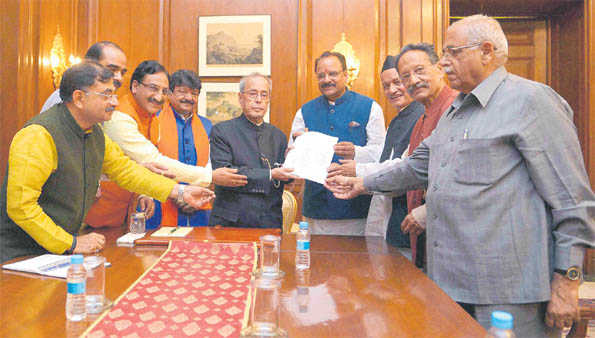
President Pranab Mukherjee receives a memorandum from a BJP team from Uttarakhand.
SMA Kazmi in Dehradun
Instability, intrigue and political one-upmanship have been synonymous with Uttarakhand since the formation of the new state on November 9, 2000, affecting development. The recent political upheaval that saw deceit, defections and sting operations involving even the Chief Minister and a ruling party legislator clearly points towards the political situation prevailing in the state. The ongoing corruption, open talk of money changing hands to buy legislators has become the hallmark of the state.
Uttarakhand was formed on the premise that a small hill state would be able to cater to the needs and aspirations of the people of Garhwal and Kumoan hills who felt marginalized being part of a bigger Uttar Pradesh. But since its formation, the state has witnessed only political intrigues and ever-rising ambitions of its leaders. Many of these leaders who could have never become even panchayat leaders during the Uttar Pradesh days are having dreams of making it big.
"Most such leaders and legislators had no experience and vision. They saw Uttarakhand as a windfall for their personal ambitions and for accumulating money through political power," says Anil Parkash Joshi, a social and environmental scientist.
It was on the eve of Uttarakhand's formation that the political game of destabilization began: two senior BJP leaders, Bhagat Singh Koshiyari and Ramesh Pokhriyal Nishank, both of whom later became CM, opposed the Nityanand Swami as the first CM and refused to take oath as cabinet ministers in the Swami interim government. It was a rebuke from central party leadership that forced the two to join the state ministry. But they continued to oppose Swami arguing he was not a 'Pahari'(from hills) and that the party would suffer in the first election to be held in February 2002.
The BJP leadership replaced Swami and made Koshiyari the CM before the 2002 polls. The results were on predictable lines. The Congress which was defunct since the 'Ram temple' agitation made a fabulous comeback and won a majority much to the shock of the BJP central leadership. Senior BJP leader and former Deputy Prime Minister LK Advani had commented that he was stunned by the results since it was the BJP that had created Uttarakhand.
The Congress high command handed the reins to veteran ND Tewari as CM. Although his five-year tenure saw some development, particularly in attracting industrialists to set up their units in the newly created Pantnagar and Haridwar industrial estates, the state also suffered from a lack of vision and direction as also from political intrigue.
The Tewari tenure saw Harish Rawat acting as a spoiler. Rawat did everything possible to unsettle the CM and acted more as an opposition leader than the ruling Congress chief.
Koshiyari was back to his game plan when the BJP defeated Congress in the second assembly polls in 2007 and Maj. Gen. B.C. Khanduri (retd) became the CM. Koshiyari got his opportunity when the party lost all five seats in the 2009 polls, forcing its leadership to replace Khanduri. However, Nishank became the CM in 2010. Khanduri was again brought by the party before the 2012 assembly polls but despite doing a good job in a few months' time, he lost the polls.
The Congress victory in 2012 led to Vijay Bahuguna becoming the CM, again prompting Rawat, who was then a Union minister in the Manmohan Singh Government, to orchestrate a campaign against Bahuguna. His supporter-MLAs continued their dharna at his residence in New Delhi for 18 days before he was placated by the offer of plum ministerial posts for his supporters in the Bahuguna ministry and a Rajya Sabha seat for a nominee.
Rawat struck after the devastating natural disaster in June 2013. There were question marks over the Bahuguna government's functioning. This apparently convinced party vice-president Rahul Gandhi to believe that Rawat was the best bet. Rawat replaced Bahuguna as CM, his lifelong ambition realized. But he tasted the same rebellion which he nurtured throughout his political career.



























